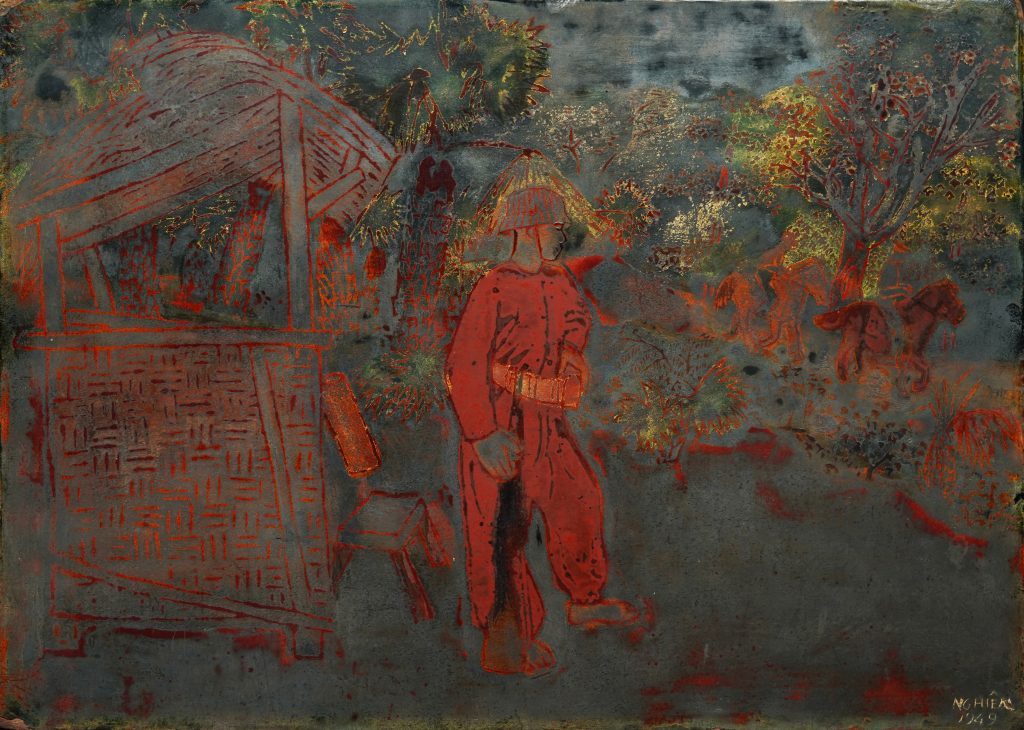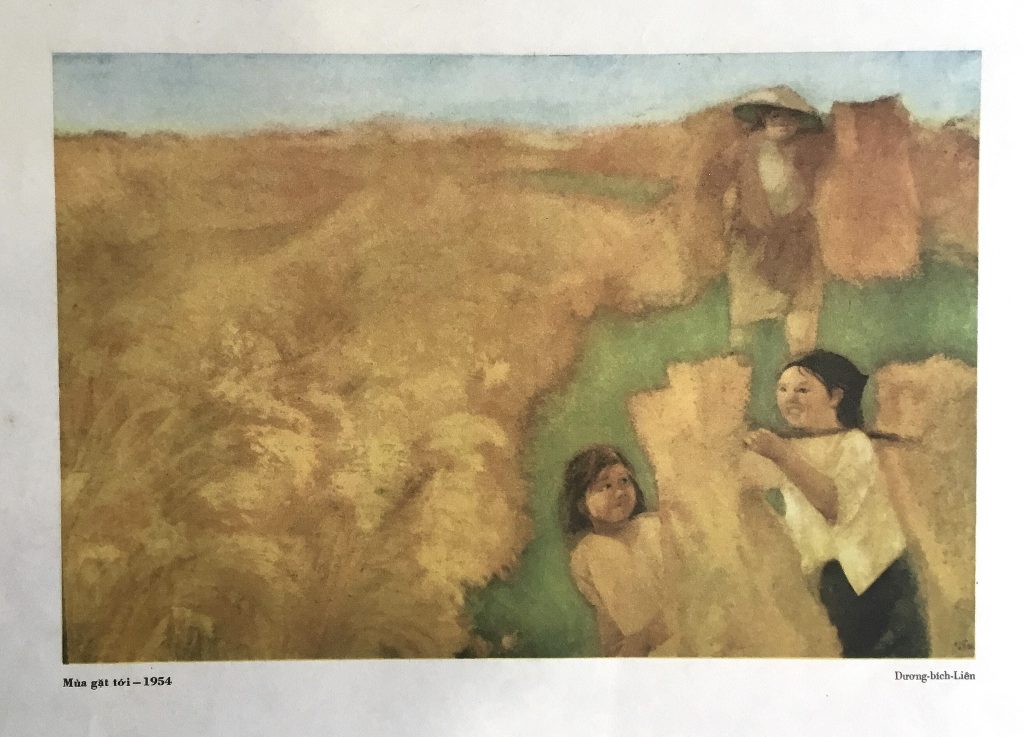Nguyen Tu Nghiem only started with lacquer during the resistance war against the French. And in fact, in this period, with lacquer, he only painted more than 10 paintings, sharing the same theme of resistance war and share the same small dimension (about 20×30cm), and also only painted in about two years 1948 and 1949.

Nguyễn Tư Nghiêm. Guard station. Lacquer. 21x30cm

Nguyễn Tư Nghiêm. Artillery squad. Lacquer. 21x30cm
Two paintings introduced here: “Guard station” and “Artillery squad” — painted by Nguyen Tu Nghiem on two sides of the same wood-body, and they certainly seem to be among his more than 10 early lacquer paintings. The remains are currently unknown about status of existence, whether they are still missing, or where they are located.
It can be said that, before coming to lacquer, Nguyen Tu Nghiem was considered a master painter in oil painting and woodblock prints. In 1944, in Hanoi, while studying at the Indochina Fine Arts College, he won the first prize at Salon Unique exhibition for all the works he attended: “Gate of Sugarcane Village” (color woodcarving), “Country scene” (oil) and “Guardian of the Temple of Literature in Son Tay” (oil).
Next, at the 1948 National Fine Arts Exhibition held in Viet Bac war zone, he won the first prize again with the color woodcut painting “Guerrilla Phu Luu”. The work was purchased by the Truth newspaper, in which it “shows some peasants in brown clothes, carrying mousquetons, bringing grenades, standing awkwardly on high green stone steps, next to it is a red-leaved winter Indian almond tree” (the word Phu Luu here may be the name of a village in Thien Loc district, Nghe An province, his hometown, now in Can Loc, Ha Tinh, not Phu Luu village in Tu Son, Bac Ninh).
Regarding the painting “Phu Luu Guerrilla”, in the book “Modern Fine Arts of Vietnam” published in 1996, artist, researcher Quang Phong wrote: “Nguyen Tu Nghiem has removed all the inherent black outlines in woodcuts ever since, so that the naked strokes are printed strongly on the background of poonah paper, creating a sense of elegance and very vivid.”
Nguyen Tu Nghiem’s artistic genius is that of an innovator, always independent, groundbreaking and extremely daring. He once used one of his oil paintings as an outline for a woodcut, and with woodcarved lacquer, he also had an excellent experience.
It is actually both natural and random when Nguyen Tu Nghiem came to lacquer. It’s natural by the need to develop art requires. It’s coincidental because it arose from a particular condition brought about by the historical context. Regarding this event, also in the book “Modern Fine Arts of Vietnam” mentioned above, in another chapter, painter Quang Phong wrote: “In 1947, To Ngoc Van was the leader of the National Salvation Cultural Delegation in Area 10, the delegation included The Lu, Phan Khoi, Bui Huy Phon, Nguyen Tuan, Nguyen Khang… acted, worked together and created. To Ngoc Van organized an engraving and printing workshop propaganda on a big hill in Xuan Ang village — in the middle of the land of Phu Tho Rhus succedaneum.

Portrait of artist Nguyen Tu Nghiem
On that great occasion, he and Nguyen Tu Nghiem took a chance to research and create lacquer paintings and also here, two artists found green, adding to the lacquer palette a cool color system that had always been lacking. In 1948, with the newly discovered green, Nguyen Tu Nghiem created a beautiful painting “The soldiers play flute under the stilt house”. A few green banana leaves suddenly appeared in the sunlight like singing along with the vermillion burgundy blooming banana, strongly stimulating a golden-vermillion color scheme, giving it a fresh complementary color, never see before in the traditional lacquer world. To Ngoc Van, who mainly contributed to finding that precious color, had to applaud in the great success. Who would have thought that green and its variations could have such a magical effect, he excitedly began to create a three-element painting ‘Evacuate in the forest’ with a combination of shades of green, but had to leave unfinished to create an oil painting ‘Hanoi is on the rise’ to attend the 1948 National Fine Arts Exhibition”.
According to a biographical note of Nguyen Tu Nghiem based on his narrative, the painting “The soldiers play flute under the stilt house” also called “Artistic activities in a artillery squad”, and it was also the first lacquer painting in his painting career, was later given as a gift to the World Congress of Youth and Students held in Berlin in 1951. The remaining paintings of the series of more than 10 small-dimension lacquer paintings on the subject of resistance war were continued to be created and scattered from 1948 to 1949, maybe not only in Xuan Ang (Ha Hoa, Phu Tho), but also include his time in charge of the studio of Vietnam Association of Culture and Arts in Thai Nguyen. It’s fortunate that in that series there are at least two of the paintings we see here. Otherwise nothing would be known about an important period of the master painter, in addition to the descriptions of historical witnesses.
“The green color in lacquer — Nguyen Tu Nghiem later said — was not a discovery, but demanded by the resistance war. Because the subject is soldier, I think of the color green”. He also said: “Everything has a reality, but do not let reality dominate.” From the beginning to the end of his career, the reality in Nguyen Tu Nghiem’s paintings is the reality of perception a “shrewd” reality, always towards the goal of creation.
Starting to create at the age of 6 and prefer squeezing rather than drawing, since he was young, he had been passionate about studying Dong Son art and sculpting communal houses and pagodas. From the bottom of his being, Nguyen Tu Nghiem is a “carving” artist, and it can be said that his carving instincts and painting always go hand in hand.
In 1949, at the Art Debate Conference organized by Vietnam Arts and Culture Association in Yen Da, Dai Tu, Thai Nguyen, while “criticizing” Nguyen Tu Nghiem’s lacquer paintings on the subject of resistance war, people still insisted that lacquer painting was not fully capable of “describing creation” as a true painting medium. And obviously at that time, Nguyen Tu Nghiem’s lacquer paintings that To Ngoc Van wholeheartedly praised and encouraged was considered as an opposite of the “realistic depiction” (which the resistance war needed), and was classified in the same category as “poetry without rhyme” – “failed” of Nguyen Dinh Thi. However, some radical ideas want to deny the value of lacquer painting under the initial impact of socialist realism then became useless. Some people thought that painting lacquer was “butting your head against the wall”. Nguyen Tu Nghiem and To Ngoc Van still saw in lacquer a “way forward”. And that path forward, through history and until today, has become more and more extensive and broad.
“Lacquer” has recently been recognized as an international term, to fix the concept of a medium of art, at the same time, it points out a distinctive and unique value of Vietnamese painting.
Particularly with two lacquer paintings present here: “Guard station” and “Artillery squad” where there is quite a convergence of the realistic view and the ability to simplify, graphicize, and carve out especially sharp of Nguyen Tu Nghiem, we seem to have fully connected his journey in lacquer art in particular, in his painting art in general.
The analysis and explanation of the birth of Nguyen Tu Nghiem’s masterpiece lacquer paintings later on are as follows: “The real calf”, “New Year’s Eve by the Sword Lake”, or “Ancient Dance”, “Giong” — since then, it seems that there have been solid and authentic scientific bases.
The fading over time of the two paintings we are seeing does not seem to have lost their inherent strength, on the contrary, making them even more fanciful, hiding within the whispering echoes emanating from the artist’s soul was immersed in an era of struggle for independence and freedom of the nation nearly three-quarters of a century ago.
NGUYEN TU NGHIEM
From the early 1960s, often signed on works as “nge”.
– Born on October 20, 1918 in Trung Can village, Nam Trung commune, Nam Dan district, Nghe An province, in a family of feudal scholars.
– Died June 15, 2016 in Hanoi, aged 98.
– Studied in 15th course of Indochina Fine Arts College (in 1941, ended March 9, 1945).
– Graduated from Vietnam Fine Arts School in Viet Bac war zone in 1952.
– Former lecturer at Vietnam Fine Arts College, Resistance Course (from 1952 to 1954), lecturer at Hanoi College of Crafts (from 1959 to 1960).
– Former painter under the Vietnam Fine Arts Association.
– Ho Chi Minh Prize for literature and art, phase I, 1996.
– Author of the lacquer painting “Giong”, created in 1990, belonging to the collection of Vietnam Fine Arts Museum, recognized as a National Treasure in 2017.







